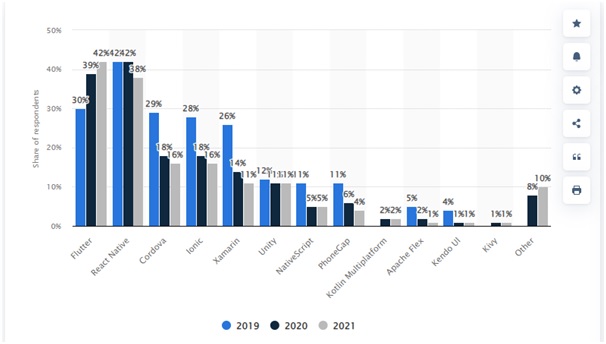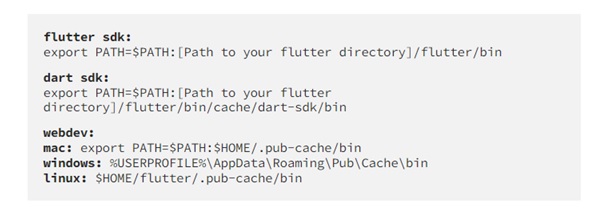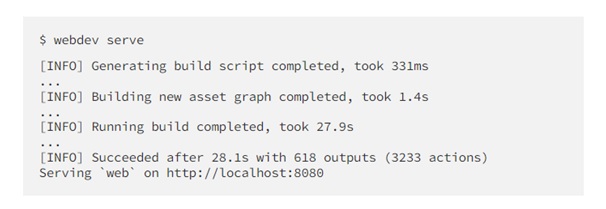The popularity of Flutter has skyrocketed for many good reasons. Initially, Flutter was only used for developing mobile applications for Android and iOS platforms but now it can also be used to create web applications. This is a new and innovative thing that developers are trying to make with Flutter app development services.
Also, big tech giants are choosing Flutter for web development because of its attractive features and characteristics. Now, Are you thinking to create a web app using Flutter?

In this blog, we will explain Flutter for the web and how you can make a successful Flutter web application.
So, let’s get started to know more!
Flutter Usage Statistics
1. As per Statista, Flutter is the most popular framework that is used for cross-platform app development according to the 2021 developer survey.

Image Source: https://www.statista.com/statistics/869224/worldwide-software-developer-working-hours/
2. According to the stack overflow survey, Flutter is used by 68% of developers

Image Source: https://stackoverflow.blog/2022/02/21/why-flutter-is-the-most-popular-cross-platform-mobile-sdk/
What is Flutter?
Flutter is an open-source software development kit that is used to build natively compiled software applications for Android, iOS, Linux, Windows, macOS, and the web from a single codebase. That means by using one programming language and one codebase two different applications can be created.
A programming language called Dart is used in the development of Flutter web applications. Previous experience in Dart and other programming languages is not required to build a Flutter web application. You can go through the official documentation that is available on their official website to know more about the basics of Flutter web. Flutter for the web renders website apps similarly in the way it works for mobile applications for both Android and iOS platforms.
Key Points to consider when building a web application using Flutter
- You should do proper in-depth market research when thinking of using Flutter for web development. This will help you to develop a more unique idea and strategy.
- Your app’s UI/UX design should be appealing that will attract the users when they will use your web app.
- The most important step is to choose the right Flutter app development company that will help you to make a user-friendly and intuitive web app.
- Testing of the app should be done properly by using different testing techniques.
Advantages Of Using Flutter For the Web
It will be worth using Flutter for the web as it provides a lot of advantages. So, now let’s have a look at some of them!
● For web and app development simultaneously
In case you want mobile and app development altogether, then Flutter is undoubtedly the right solution for you. Additionally, it is time-saving and cost-effective at the same time because the web and mobile apps share the same standard logic, UI elements, styles, and more.
Responsive user interfaces need to be created as web and mobile apps have different looks and these will work on different screen sizes and resolutions.
● Re-usage of code
If your business has already a mobile application and now you want a web application as well then Flutter for web development can be a perfect choice. As it allows the reuse of code that means you can easily reuse the existing UI elements.
● Companionship
Flutter for the web is a trustworthy companion to mobile applications. For example, if an demo mobile application is made then it can use the same standard code written with a broader system made with Flutter.
Pros Of Flutter Web
- Flutter allows PWA support
- It helps developers to build unique and interactive web applications.
- Flutter provides assistance for both Cupertino and Material design UI elements.
- It can easily integrate with the present web applications as an embedded element.
- Developers can easily run JavaScript code from within the Flutter web.
- It allows full support to all existing dart libraries that run on the web.
- Huge amounts of data can be managed by using Flutter web.
- It provides large access to open-source libraries on the pub. dev which can be further used in the development process.
Cons Of Flutter Web
- Unfortunately, Flutter web is not SEO friendly. That’s why in terms of marketing the product there are several better options available from other web frameworks.
- Flutter web has a limited set of tools and libraries and has restrictions on the Flutter APIs support.
- It can not modify the already existing JavaScript, CSS, and HTML code.
- It looks less impressive in comparison with classic web development.
- It has a large file size and during the web’s loading, it may look poor.
How To Create And Run a Flutter Web Application
● Installation process
You need Flutter 1.5 and above to make a web application using Flutter as It comes with the support of Dart compilation to JavaScript. By running the flutter upgrade on your machine you can make sure that you have achieved the Flutter v.1.5.4.

Webdev package provides the tools for Flutter web. So to install that run the following command.

You should ensure that the $HOME/. pub-cache/bin directory is in your path and after that, you can use the webdev command directly from the terminal.
Next, to add $HOME/. pub-cache/bin directory to your path, call the path file by running the below command.

Now the file will be opened with text edit and you should make a reference to all your components and save it.

Now, without any further wait let’s move on to the further step.
● Flutter Web Development Tools
After the installation process, you need an IDE (Integrated Development Environment) to start the development of your web application. Here we are going to explain 3 IDEs step by step that you can use according to the instructions.
1. Visual studio code
- First, install the Flutter software development kit (SDK).
- Then set up the VS Code.
- Now, configure VS Code to your local Flutter SDK.
- After that run the command Flutter: New Web Project from VS Code.
- Now when the project is created, run the app by pressing F5.
- The VS code will use the webdev tool to build and run your application.
- In the end, a new chrome window will open and you can see your application is running.
2. IntelliJ
- First, install the Flutter software development kit (SDK).
- Then set up the IntelliJ.
- Now, configure IntelliJ to your local Flutter SDK.
- After configuration create a new Dart project. It should keep in mind that for the Flutter web application. You need to start from the Dart project wizard and not from the Flutter project wizard.
- Select the “Flutter for web” option from the Dart project wizard for the application template.
- Pub get will run automatically as soon as the project will be created.
- After the project creation, click the run button on the main toolbar.
- IntelliJ will use the webdev tool to build and run your application.
- In the end, a new chrome window will open and you can see your application is running.
3. Android Studio
In Android Studio you need to use the Stagehand package as it has no direct plugin or template to create a web project. Basically, Stagehand is a Dart project scaffolding generator that is inspired by the tools like Web Starter Kit and Yeoman.
- First, install the Flutter software development kit (SDK).
- Then set up the Android Studio.
- Now, configure Android Studio to your local Flutter SDK.
- To install the Stagehand, run the following command $ pub global activate stagehand.
- Below is an example to create a web project using Stagehand:

To list all the project templates:

After the project is created, open the Android Studio and add the below dependencies in your pubspec.yaml file.

● To download all the necessary files, run pub get from the terminal.
● After that, create a lib folder in the root directory.
● After creating the lib folder, create a main. dart file in it and paste the below code into it.

● After that open the main. dart file and paste the below code in it.

● After a long process, now you are ready to test your web project. Run the app by typing the below command in the terminal.

Open the local host in chrome and you can see the Hello World in red text.
Conclusion
The popularity of Flutter is increasing day by day and it has proved to bring more value to your business. It is an ideal platform for building web applications like PWAs (Progressive web apps) or SPAs and also helps to bring existing mobile apps to the web.
After reading the whole blog, you might be thinking of creating a web application. So you can collaborate with us to have the best web application for your brand.
DianApps is a reliable flutter app development company having a dedicated team of experienced Flutter app developers that will help you to create responsive web applications.
FAQs
1. Is Flutter suitable for web development?
Yes, along with app development Flutter is appropriate for web development as well. By using it existing code can easily be embodied into the web browser to create a new application.
2. What exactly is Flutter for the web?
Flutter for the web will help you to develop web applications using Flutter. Additionally, it allows sharing of code between different platforms.
3. Which programming language is used in Flutter?
This popular framework uses Dart as its primary programming language to build natively compiled applications for web, mobile, and desktop.
